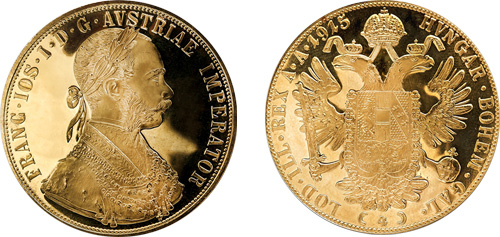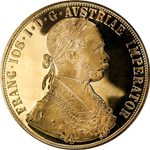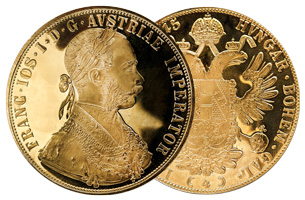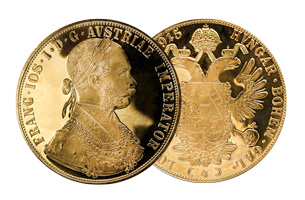Gold ducats were first issued by the Kingdom of Austria in the early 17th century. The ducat is a gold coin that was traded throughout Europe from the 12th century until World War I. Most European countries used ducats, including the Netherlands, Russia, Sweden, and Austria. In 1284, the first gold ducat, also called zecchino d’oro (Italian for “gold sequin”), was struck in Venice. Ducats became a standard gold coin throughout Europe, especially after they were officially imperially sanctioned in 1566. Ducats were struck in high purity gold, 233/4 carats, making them one of the purest gold coins ever produced for circulation.
The first ducats issued by Austria were produced in 1612 and probably earlier. The Austrian Mint ceased issuing ducat coins in 1914 during the last years of Franz Joseph I, emperor of the Austro-Hungarian Empire. One and 4-ducat coins issued 1915 are still being produced by the Austrian Mint as official re-strikes. It is important to note that none of the 1915 dated ducats were actually struck in 1915. All of the 1915 re-strikes (of which 996,721 were struck between 1920 and 1936) are worth their weight in gold; thus, they are considered a bullion rather than a numismatic coin.

The 1915 one ducat coin features the laureate head, facing right, of Emperor Franz Joseph I, as well as the inscriptions “FRANC IOS I D G AUSTRIAE IMPERATOR” on the obverse side. The reverse design shows the arms of Austria superimposed upon a crowned double-headed Imperial eagle and the inscriptions “HUNGAR BOHEM GAL LOD ILL REX A A 1915.” The design of the 1915 4-ducat coin is almost identical, except that the obverse side shows the Emperor’s profile bust and the reverse displays the coin’s denomination “4.” The ducats are very thin compared to other gold coins.
Each Austrian 4-ducat contains .4438 oz fine gold, while each one ducat holds .1106 fine gold.
Traditionally, the Kingdom of Austria commemorated its deceased rulers by issuing coins bearing their portrait posthumously. Following the death of Francis I in 1765, his widow, Maria Theresa decreed on July 21, 1766 that coins should feature the portrait of her deceased husband along with his date of death. Moreover, alphabetical mintmarks were used to indicate the actual year of the issue, e.g. A = 1766. The posthumous coins were released erratically. After the death of famous Empress Maria Theresia in 1780, the popular Maria Theresia Thaler continued to be produced bearing her portrait and the year of her death.
Since the one and 4-ducat coin are re-strikes and are produced in large numbers, they are considered bullion issues and do not really have any numismatic value. Still, Austrian ducats are high in gold purity and exhibit excellent craftsmanship.



